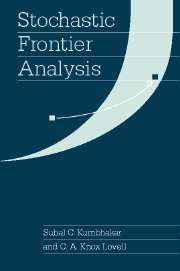Book contents
- Frontmatter
- Contents
- Preface
- 1 Introduction
- 2 Analytical Foundations
- 3 The Estimation of Technical Efficiency
- 4 The Estimation and Decomposition of Cost Efficiency
- 5 The Estimation and Decomposition of Profit Efficiency
- 6 The Shadow Price Approach to the Estimation and Decomposition of Economic Efficiency
- 7 Incorporating Exogenous Influences on Efficiency
- 8 The Estimation of Efficiency Change and Productivity Change
- References
- Author Index
- Subject Index
8 - The Estimation of Efficiency Change and Productivity Change
Published online by Cambridge University Press: 05 June 2012
- Frontmatter
- Contents
- Preface
- 1 Introduction
- 2 Analytical Foundations
- 3 The Estimation of Technical Efficiency
- 4 The Estimation and Decomposition of Cost Efficiency
- 5 The Estimation and Decomposition of Profit Efficiency
- 6 The Shadow Price Approach to the Estimation and Decomposition of Economic Efficiency
- 7 Incorporating Exogenous Influences on Efficiency
- 8 The Estimation of Efficiency Change and Productivity Change
- References
- Author Index
- Subject Index
Summary
INTRODUCTION
Productivity change occurs when an index of outputs changes at a different rate than an index of inputs does. Two questions immediately arise. First, how can productivity change be measured? Second, what are the sources of measured productivity change? Diewert (1992) has answered the first question. Productivity change can be calculated using index number techniques to construct a superlative Fisher (1922) or Törnqvist (1936) productivity index. Both indexes require quantity and price information, as well as assumptions concerning the structure of technology and the behavior of producers, but neither requires the estimation of anything. Productivity change can also be calculated using nonparametric techniques, or estimated using econometric techniques, to construct what has come to be known as a Malmquist (1953) productivity index. These latter techniques do not require price information or technological and behavioral assumptions, but they do require calculation or estimation of a representation of production technology. Thus information on the structure of the technology that generates the quantity data can serve as a substitute for price data and assumptions.
A disadvantage of index number techniques is that they do not provide an answer to the second question, whereas nonparametric techniques and econometric techniques do. Although nonparametric techniques and econometric techniques are capable of providing answers to both questions, only the econometric approach is capable of doing so in a stochastic environment. In this chapter we show how to use econometric techniques to estimate the magnitude of productivity change, and then to decompose estimated productivity change into its various sources.
- Type
- Chapter
- Information
- Stochastic Frontier Analysis , pp. 279 - 310Publisher: Cambridge University PressPrint publication year: 2000
- 2
- Cited by



